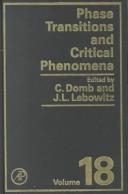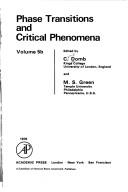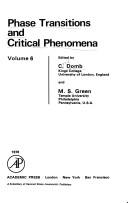| Listing 1 - 10 of 331 | << page >> |
Sort by
|
Book
Year: 1963 Publisher: New York (N.Y.): Benjamin,
Abstract | Keywords | Export | Availability | Bookmark
 Loading...
Loading...Choose an application
- Reference Manager
- EndNote
- RefWorks (Direct export to RefWorks)
Book
Abstract | Keywords | Export | Availability | Bookmark
 Loading...
Loading...Choose an application
- Reference Manager
- EndNote
- RefWorks (Direct export to RefWorks)
THERMODYNAMICS --- CRITICAL PHENOMENA --- PHASE TRANSITIONS --- THERMODYNAMICS --- CRITICAL PHENOMENA --- PHASE TRANSITIONS
Book
Abstract | Keywords | Export | Availability | Bookmark
 Loading...
Loading...Choose an application
- Reference Manager
- EndNote
- RefWorks (Direct export to RefWorks)
THERMODYNAMICS --- CRITICAL PHENOMENA --- PHASE TRANSITIONS --- THERMODYNAMICS --- CRITICAL PHENOMENA --- PHASE TRANSITIONS
Book
Abstract | Keywords | Export | Availability | Bookmark
 Loading...
Loading...Choose an application
- Reference Manager
- EndNote
- RefWorks (Direct export to RefWorks)
THERMODYNAMICS --- CRITICAL PHENOMENA --- PHASE TRANSITIONS --- THERMODYNAMICS --- CRITICAL PHENOMENA --- PHASE TRANSITIONS
Book
ISBN: 3662457687 Year: 2016 Publisher: Berlin, Heidelberg : Springer Berlin Heidelberg : Imprint: Springer Spektrum,
Abstract | Keywords | Export | Availability | Bookmark
 Loading...
Loading...Choose an application
- Reference Manager
- EndNote
- RefWorks (Direct export to RefWorks)
Lehrbuch zur Experimentalphysik Band 2. Thermodynamik Dieses Buch zur Experimentalphysik ist nach dem bereits erschienenen ersten Band zur Mechanik der zweite Band der lange erwarteten Ausarbeitung der überaus beliebten Vorlesungen von Joachim Heintze, welcher sich mit der Kontinuumsmechanik und Thermodynamik beschäftigt. Die Liebe des Autors für die Physik und für spannende und historische Experimente ist in das Buch eingegangen und in allen Kapiteln unvermindert zu spüren. Hier finden Sie alle für das Bachelor- und das Nebenfachstudium der Physik relevanten Themen in anschaulicher und besonders gut verständlicher Form mit vielen Abbildungen präsentiert. Übungsaufgaben mit ausführlichen Lösungen erleichtern die Prüfungsvorbereitung. Ob Physik Ihr Hauptfach sein mag oder ein Begleitfach − in jedem Fall werden Sie von den klaren Erläuterungen und den eingängigen Darstellungen profitieren und vieles mitnehmen, das Sie auf Ihrem weiteren Weg begleiten wird. "Möge dieses Buch dazu dienen, allen Studenten die Schönheit der Physik aufzuzeigen, Zusammenhänge zu sehen, das Studium zu erleichtern und damit dieses Vermächtnis zu erkennen und weiter zu tragen." Hans-Georg Siebig Zum Inhalt Mechanik deformierbarer fester Stoffe; Ruhende Flüssigkeiten und Gase; Strömende Flüssigkeiten und Gase; Phänomenologische Grundlagen der Wärmelehre; Kinetische Gastheorie; Transporterscheinungen; Wärmestrahlung; Grundbegriffe der Thermodynamik; Der II. Hauptsatz der Wärmelehre; Phasenübergänge; Reale Gase, tiefe Temperaturen; Systeme mit veränderlicher Teilchenzahl, Gasentartung.

ISBN: 0122203011 012220302X 0122203038 0122203054 0122203518 0122203070 9780122203015 Year: 1972 Publisher: London Academic press
Abstract | Keywords | Export | Availability | Bookmark
 Loading...
Loading...Choose an application
- Reference Manager
- EndNote
- RefWorks (Direct export to RefWorks)
Critical phenomena (Physics). --- Critical phenomena --- Phase transitions --- Thermodynamics
Book
ISBN: 3319108433 Year: 2015 Publisher: Cham : Springer International Publishing : Imprint: Springer,
Abstract | Keywords | Export | Availability | Bookmark
 Loading...
Loading...Choose an application
- Reference Manager
- EndNote
- RefWorks (Direct export to RefWorks)
This second edition of a successful and highly-accessed monograph has been extended by more than 100 pages. It includes an enlarged coverage of applications for materials characterization and analysis. Also a more detailed description of strategies for determining free energies of ion transfer between miscible liquids is provided. This is now possible with a “third-phase strategy” which the authors explain from theoretical and practical points of view. The book is still the only one detailing strategies for solid state electroanalysis. It also features the specific potential of the techniques to use immobilized particles (for studies of solid materials) and of immobilized droplets of immiscible liquids for the purpose of studying the three-phase electrochemistry of these liquids. This also includes studies of ion transfer between aqueous and immiscible non-aqueous liquids. The bibliography of all published papers in this field of research has been expanded from 318 to now 444 references in this second edition. Not only are pertinent references provided at the end of each chapter, but the complete list of the cited literature is also offered as a separate chapter for easy reference.

Abstract | Keywords | Export | Availability | Bookmark
 Loading...
Loading...Choose an application
- Reference Manager
- EndNote
- RefWorks (Direct export to RefWorks)
536 --- Heat. Thermodynamics --- 536 Heat. Thermodynamics --- Critical phenomena --- Phase transitions --- Thermodynamics

Abstract | Keywords | Export | Availability | Bookmark
 Loading...
Loading...Choose an application
- Reference Manager
- EndNote
- RefWorks (Direct export to RefWorks)
536 --- Heat. Thermodynamics --- 536 Heat. Thermodynamics --- Critical phenomena --- Phase transitions --- Thermodynamics
Book
ISBN: 940077642X Year: 2014 Publisher: Dordrecht : Springer Netherlands : Imprint: Springer,
Abstract | Keywords | Export | Availability | Bookmark
 Loading...
Loading...Choose an application
- Reference Manager
- EndNote
- RefWorks (Direct export to RefWorks)
Over the course of the last century it has become clear that both elementary particle physics and relativity theories are based on the notion of symmetries. These symmetries become manifest in that the "laws of nature" are invariant under spacetime transformations and/or gauge transformations. The consequences of these symmetries were analyzed as early as in 1918 by Emmy Noether on the level of action functionals. Her work did not receive due recognition for nearly half a century, but can today be understood as a recurring theme in classical mechanics, electrodynamics and special relativity, Yang-Mills type quantum field theories, and in general relativity. As a matter of fact, as shown in this monograph, many aspects of physics can be derived solely from symmetry considerations. This substantiates the statement of E.P. Wigner "... if we knew all the laws of nature, or the ultimate Law of nature, the invariance properties of these laws would not furnish us new information." Thanks to Wigner we now also understand the implications of quantum physics and symmetry considerations: Poincare invariance dictates both the characteristic properties of particles (mass, spin, ...) and the wave equations of spin 0, 1/2, 1, ... objects. Further, the work of C.N. Yang and R. Mills reveals the consequences of internal symmetries as exemplified in the symmetry group of elementary particle physics. Given this pivotal role of symmetries it is thus not surprising that current research in fundamental physics is to a great degree motivated and inspired by considerations of symmetry. The treatment of symmetries in this monograph ranges from classical physics to now well-established theories of fundamental interactions, to the latest research on unified theories and quantum gravity.
Mathematical physics. --- Elementary particles (Physics). --- Quantum field theory. --- Phase transitions (Statistical physics). --- Gravitation. --- Theoretical, Mathematical and Computational Physics. --- Elementary Particles, Quantum Field Theory. --- Phase Transitions and Multiphase Systems. --- Classical and Quantum Gravitation, Relativity Theory. --- Mathematical Physics.
| Listing 1 - 10 of 331 | << page >> |
Sort by
|

 Search
Search Feedback
Feedback About UniCat
About UniCat  Help
Help News
News